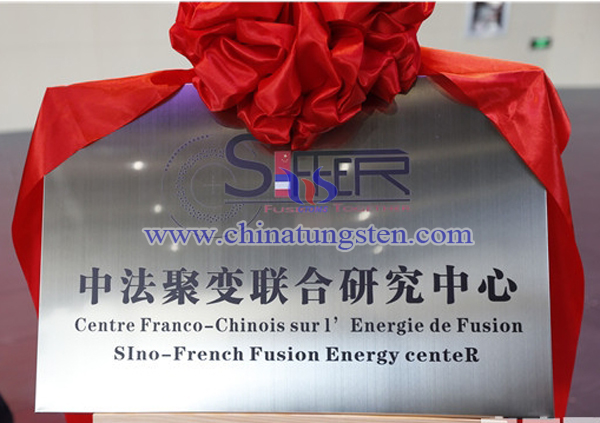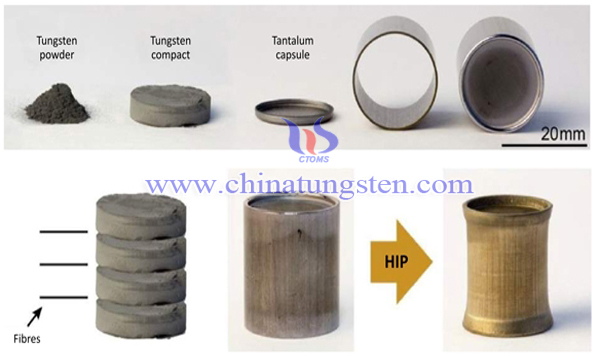China and France will Jointly Develop New Fusion Energy
- Details
- Category: Tungsten's News
- Published on Saturday, 06 October 2018 23:11
On the morning of January 11, 2018, the unveiling ceremony of the Sino-French Joint Fusion Research Center, established by the agreement between the Ministry of Science and Technology and the French Atomic Energy Commission, was held on the Hefei Science Island, marking a new phase in the practical cooperation between China and France in the field of fusion energy, from then on, cooperation between the two scientific research institutions has risen to bilateral cooperation between governments.

China-France fusion science and technology cooperation began in the 1980s, France Toresupra device and China's HT-7 device launched as long as 25 years of scientific and technological cooperation, gradually transformed into China's EAST device and France's WEST device cooperation. The WEST device is an all tungsten divertor Tokamak device upgraded from the Tore Supra superconducting Tokamak device by the Nuclear Fusion Research Institute of the French Atomic Energy Commission. EAST is the world's first full superconducting tokamak nuclear fusion experimental facility. Previously, the two sides have set up a joint laboratory, and have carried out fruitful cooperation in the WEST ion cyclotron antenna development, EAST teleoperation system, joint physical experiments, Tokamak long pulse operation research and other aspects and achieved rich results.
In November last year, the two sides signed a framework agreement on the fusion research center. It mainly focuses on supporting, developing and validating key components and technologies of magnetic confinement fusion devices for ITER organizations and their members, conducting joint bidding for projects of common interest, fusion science and experimental physics research, nuclear fusion energy safety standards and technical standards, and next generation fusion reactor devices.
The joint center has established the WEST tungsten divertor R & D as the first joint research project. Through the implementation of this project, Chinese and French scientists have established experience in the design, production, installation, operation and maintenance of tungsten divertors, laying a human and technical foundation for the future joint competition ITER divertor procurement package.
European achievements in tungsten materials for fusion reactors
Tungsten with the highest melting point of the metallic elements is considered to be a major candidate for the first wall of a fusion reactor plasma vessel. This is because it reliably resists harsh operating conditions in these reactors caused by transient heat loads, thermal fatigue, neutron irradiation and corrosion for long periods of time.
However, due to its low hydrogen retention, low corrosion rate and acceptable activation under neutron radiation, tungsten satisfies the requirements of high strength and plasma compatibility, so the metal has low toughness when operated or operated below the ductile-brittle transition temperature.
The brittleness of tungsten is an important factor limiting its application in fusion reactor PFC. It is generally believed that there are three main sources of brittleness: 1. A large number of dislocation movements in tungsten often require high temperature to activate; 2. Low solubility impurities in tungsten are often difficult to eliminate in industrial production process; O, N, H and other harmful impurities tend to segregate at the tungsten grain boundary and weaken the brittleness of tungsten; 3. Recrystallization embrittlement and irradiation embrittlement often occur in tungsten under high heat flux loading and high energy neutron irradiation. Therefore, the brittleness of tungsten will reduce the service life of PFC and thus threaten the safety of fusion devices. Improving the toughness of tungsten-based materials is one of the important topics in the field of fusion materials.
At the European Panshi Symposium in June last year, European scientists demonstrated their work on improving tungsten embrittlement by using novel tungsten fiber reinforced materials to increase PFC toughness, introducing conventional chemical vapor deposition (CVD) technology for alternative treatment routes for Wf/W composites, and then using hot isostatic pressing by sintering tungsten fiber reinforced tungsten (Wf / W) to prepare bulk fiber toughened tungsten-based materials, large-scale components were obtained.
Scientists point out that tungsten fiber reinforced tungsten (Wf / W) toughens intrinsically brittle tungsten materials by introducing energy dissipation mechanisms similar to ceramic matrix composites. These mechanisms, such as fiber pull-out or crack deflection at a particular fiber substrate, result in a decrease in peak stress at the crack tip, thus significantly improving the resistance of tungsten to crack growth.
Two kinds of tungsten powders with average particle sizes of D50=8.7 micron and D50=8.8 micron were used to study the hot isostatic pressing treatment of Wf/W samples. The tablets were molded at 110 MPa and 185 MPa to produce tablets with a diameter of 19 mm and a height of 4-5 mm, with green densities of about 51.5% and 58%.
Four pellets with the same green density were filled with tantalum (Ta) capsules, in which a single tungsten fiber (wire) was placed between adjacent tablets. The capsule is sealed with Ta cover and sealed by electron beam in vacuum. The diameter of the W fiber used is 150 micron m, which is made by hot drawing. The fibers were coated on the Er2O3 interface by reactive magnetron sputtering with coating thickness adjusted to 1,2 and 3 microns and cut into 10 mm lengths.
The packaging material was densified by hot isostatic pressing (HIP) at a constant pressure of 200 MPa, and the sintering temperature was changed between 1300 and 1900%. In all HIP operations, the residence time of 4 hours at maximum temperature remains constant. The authors report that temperatures ranging from 1500 to 1600 degrees centigrade require a density of 98% higher than the theoretical density at 200 MPa.
Although the fiber pullout behavior of CVD samples is predicted as predicted by the shear lag model, the hot isostatic pressing (HIP) Wf / W samples show a superposition effect, which hinders reasonable conclusions about the interface parameters of the system. In order to clarify the significant difference between the launch behavior of HIPed and CVD samples, more in-depth studies of the matrix-interface region and its evolution are needed. However, regardless of this result, their research provides optimized hot isostatic pressing (HIP) processing parameters that enable the manufacture of larger-scale fusion reactor plasma components to further apply the material to desired applications. (China Tungsten online: Weiping comprehensive collation, mainly from the official website of the Chinese Academy of Sciences)
- Tungsten Manufacturer & Supplier, Chinatungsten Online: www.chinatungsten.com
- Tungsten News & Prices of China Tungsten Industry Association: www.ctia.com.cn
- Molybdenum News & Price: news.molybdenum.com.cn
- Tel.: 86 592 5129696; Fax: 86 592 5129797; Email: sales@chinatungsten.com



 sales@chinatungsten.com
sales@chinatungsten.com